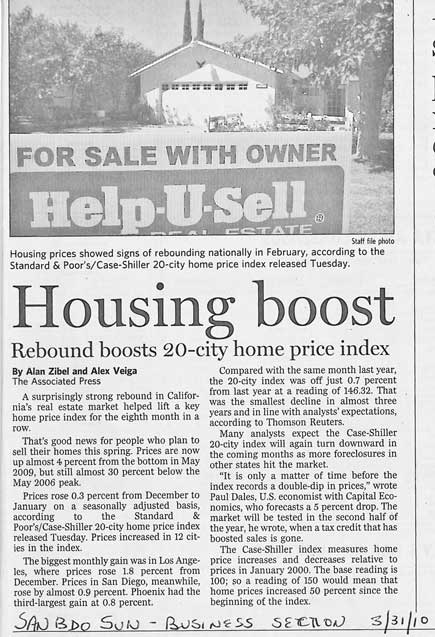If you are one of the many Help-U-Sell Brokers who already understand this, please skip ahead.
This is about the various websites Help-U-Sell Brokers may have, how they relate and what’s required to manage them.
Until the first week of March, 2010, all Help-U-Sell Broker websites were hosted and maintained by outside vendors. The two biggest vendors — the ones who had most of our offices — were Fidelity and Point2Agent. Your office website — not the one that was just released a few weeks ago, but the one you’ve had for a couple of years — was not hosted or configured by Help-U-Sell. Both of those vendors and several others have done an admirable job of keeping our offices present on the Internet for some time. But here’s where the confusion comes in.
Fidelity, the vendor for many Help-U-Sell office websites, decided to pass that business on to the sub-contractor who had been doing the work all along: NewHomePage.com. In order to maintain their old Help-U-Sell office sites, brokers who had been with Fidelity needed to sign a new agreement with NewHomePage.com. Pricing didn’t change, but the name of the vendor did. Unfortunately this change occurred within a couple of weeks of the release of the new Help-U-Sell websites and some of you have made the assumption that the NewHomePage.com websites are the new broker sites everyone’s been talking about. They are not.
The new Help-U-Sell office websites were released the first week of March during the Tech Summit. To see your new site, go to a website address configured this way:
www.yourofficename.helpusellbeta.com
For example, if your company name is Help-U-Sell Acme Realty, you’d enter: www.acmerealty.helpusellbeta.com.
The new broker websites are a work of art, brilliantly designed from the bottom up to be attractive to search engines and to permit tons of easy customization and optimization. These sites will become major lead generators for our offices but they will take some initial work on the broker’s part and some ongoing involvement to achieve maximum effectiveness. That’s what the Tech Summit was about. ***
The question is: now that you have the new Help-U-Sell office website provided by the company, do you still need your Point2Agent or NewHomePage.com website? The answer is ‘Yes,’ for a number of reasons.
First: IDX. You probably have IDX set up for your old website and it is automatically feeding your listings and those of your MLS to your website. Getting the same IDX feed to your new Help-U-Sell website requires a new agreement between you, Help-U-Sell, and your MLS. Once that’s in place, it takes some time to map the IDX feed to fit into the Help-U-Sell site. Until you have IDX up and functioning on your new website, you should keep the older site that already has IDX.
Second: Traction. Even when you get IDX on your website, even after you customize and optimize it to draw consumer interest, it will take awhile for the Search Engine Spiders to crawl your site and see what’s there so that they can include your new website in search results. I wouldn’t drop the old site until you are getting at least as many inquiries from the new site.
Third: Leads. Put plainly: If your current Poin2Agent or NewHomePage.com website is producing a reasonable number of leads each month for you, why cancel it at all? It’s perfectly fine to have more than one website, each one pulling a set of leads for your office, so long as they conform with Help-U-Sell Logo and Trademark guidelines.
Managing your new Help-U-Sell office website is easy and a complete guide is in the Download Library (under Tech Summit Materials). However there is one area where some confusion seems present, and it’s Listings.
The new broker site will extract your new listings out of your IDX feed and display them on your website. This means, if you put the listing in MLS, it’s going to find its way to your Help-U-Sell website automatically. That great! It means you don’t have to double input on your new listings. HOWEVER: once your new Help-U-Sell site has the listing, any changes you make to it in MLS will not reflect on your Help-U-Sell site. You’ll need to make price changes, report properties under contract and sold in OMS in order for the changes to reflect on the website. You’ll also need to manually remove listings from your new Help-U-Sell website in the unfortunate event they expire without selling.
There’s another reason to be particularly involved with your listings in OMS. Our system permits levels of customization that are not allowed by most MLS’s. We have space for dozens of photos and virtual tours as well as comment and feature fields that may not be available at MLS. So, when you get a new listing, put it into MLS, wait a few moments, then open up OMS, find your new listing and customize it any way you want.
***NOW HERE”S THE BIG NEWS
The current series of Tech Tuesday Teleconferences ends with next Tuesday’s meeting. Beginning the next week, on Tuesday, April 13, Tech Tuesday will go back to basics. We’ll start all over and go step by step, through your websites, learning how to work with them, with OMS and with the Content Management System, etc. When you get your email notice that it’s time to re-up for the Tech Series, please follow the link and get ‘er done.

